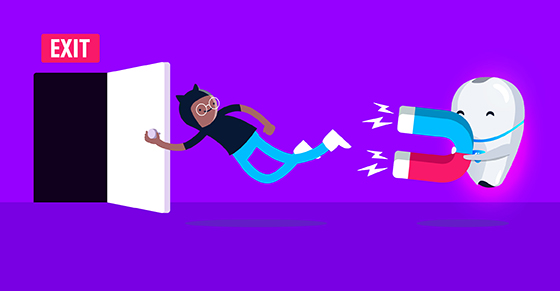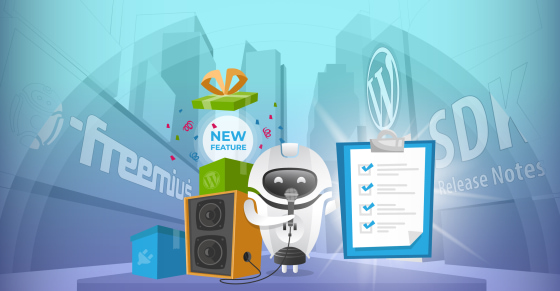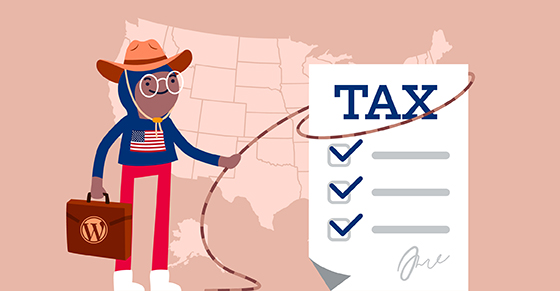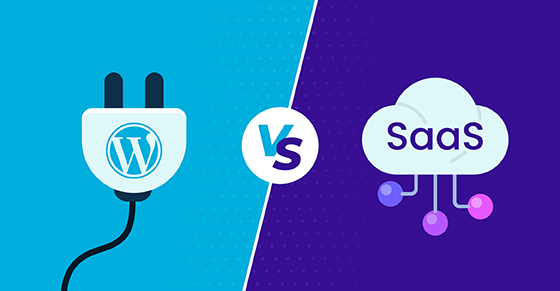|
|
In the ever-evolving realms of WordPress and SaaS, the battle against customer churn is like a high-stakes game of chess. With each move, software product makers must strategize, adapt, and anticipate customer needs. After all, in the digital age, customer loyalty is the ultimate currency, and keeping users engaged is the most effective way for software businesses to achieve success and build on it.
In many ways, software creators have to play the ‘long game’ to reduce customer churn and increase subscription renewal rates — delivering an exceptional user experience, providing stellar customer support, and consistently improving your product all contribute to achieving this.
However, these measures are long-term, non-negotiable strategies that all businesses need to commit to; they don’t tap into the ‘real-time moment’ a user cancels a subscription or a prospect abandons their cart.
When time is of the essence, software developers need to have certain contextual tactics up their sleeves to persuade users to reconsider and prospects to follow through. But before we explore them, let’s brush up on customer churn and what it means for entrepreneurs and their software businesses in 2023.
(if you’re savvy on the customer churn definitions and explanations, skip ahead to the four low-hanging fruit strategies)
Explaining Customer Churn in SaaS and WordPress Software Businesses
Customer churn refers to the rate at which customers cancel a subscription-based software product or service. More than just a metric on a dashboard, customer churn is a reflection of a company’s ability to satisfy and retain its user base. A high churn rate can disrupt revenue streams, hinder growth, and even jeopardize the very existence of a SaaS or WordPress business.
Monthly customer churn rates in software businesses generally range between 5% and 7%. That said, this can be higher for smaller businesses and startups and lower for companies servicing larger clients:
- Businesses servicing the SMB segment typically have a monthly customer churn rate of between 3% and 7% (31% to 58% annual churn)
- Mid-market companies sit between 1% and 2% (11% to 22% annual churn)
- Companies servicing enterprise-level businesses see a 0.5% to 1% average customer churn rate (6% to 10% annual churn)
- In 2022, the average churn rate of annual subscriptions for WordPress products was 29% for plugins and 29.3% for themes
Standing against ongoing attrition is customer retention, which has the proven potential to increase profits exponentially. Industry research suggests that a 5% increase in retention can drive profits up by 5% to 125%. This data makes holding onto your clientele worth the extra effort, wouldn’t you say 😉?
Typically, customer churn is placed in two categories:
Types of Customer Churn (Voluntary vs. Involuntary)
Voluntary churn: This occurs when customers actively choose to cancel their subscriptions. They may do so for various reasons, such as finding an alternative solution, budget constraints, or the software not meeting their needs (we’ll expand on these reasons in a bit).
Involuntary churn: Involuntary churn happens when customers are forced to cancel their subscriptions due to factors beyond their control. Common reasons include payment failures, credit card expirations, or technical issues. Reducing involuntary churn requires proactive measures like improving billing systems and customer support.
How to Calculate Customer Churn Rate
To calculate your software business’s customer churn rate, use this formula:
Customer Churn Rate = (Customers at the beginning of a period minus Customers at the end of a period) / Customers at the beginning of a period
For example, if you start a month with 1000 customers and end with 950, your churn rate for that month is (1000 – 950) / 1000 = 5%. As mentioned, an acceptable monthly churn rate is 5% to 7% for smaller SaaS and WordPress businesses — anything at 10% or above should sound the alarm bells that your customer experience (or potentially even some aspects of your product offering) needs improvement.
What Causes Customer Churn in SaaS and WordPress Software Businesses?
Several factors contribute to customers canceling their subscriptions and prospects abandoning their carts:
- Competitive offerings: The availability of better or cheaper alternatives can lure customers away, especially if they’re feeling neglected or if their feedback is being disregarded.
- Pricing: 10% of users seek alternatives if they’re not satisfied with a product or service’s current pricing.
- Added costs at checkout: Often, additional costs like taxes can scare potential customers away from following through with the checkout process.
- Poor user experience: If customers find the software difficult to use, they may opt for more user-friendly alternatives.
- Lack of value over time: If customers don’t perceive long-term value or don’t see the software meeting their evolving needs, they are more likely to churn.
- Billing and payment issues: Technical problems or payment failures can lead to involuntary churn. Prospects are also more likely to abandon their carts at checkout if their payment method of choice is not available.
- Customer support: Inadequate or slow customer support can frustrate users, leading to cancellations.
To mitigate the above for the long term, subscription software businesses — especially software SMBs and entrepreneurs — need to play the ‘long game’ I mentioned earlier. I.E. you should focus on customer satisfaction, ongoing product development, efficient billing systems, and above-and-beyond customer support.
Subscribe and grab a free copy to start Mastering SEO on the WordPress.org Repository
Make the WordPress.org search algorithm work for you with actionable tips to rank your plugin higher.

The Impact of Customer Churn on Subscription-Based SaaS and WordPress Product Businesses
High customer churn rates can significantly impact the growth and profitability of software businesses. They can also be the death knell for businesses in their infancy, where early growth and product adoption are necessary to progress.
In 2023, the average ratio of lifetime value (LTV) to customer acquisition cost (CAC) was 6:1. The average CAC for SaaS companies can range from $500 to $5,000 per customer and it often takes several months or more to recoup these costs through subscription fees.
Some eye-opening stats on the impact of customer churn and decreasing subscription renewals:
- Revenue loss: This one’s obvious, but it needs to be said. Churn burns through recurring revenue, which can be especially detrimental for SMBs and entrepreneurs that rely heavily on steady, predictable income streams.
- Customer acquisition costs: It costs 5 times more to acquire new customers than it does to keep current ones, so a high churn rate will end up creating a costly imbalance in your business.
- Brand reputation: Frequent churn can damage a business’s reputation, making it harder to attract and retain customers in the future. After all, people are 4 times more likely to purchase when a friend refers them, and successful referrals have a 16% higher LTV. If a brand’s reputation is spotty, the less likely it can count on users being advocates.
- Reduced growth: Customer churn can stall growth as a business must continually replenish its user base to maintain revenue levels. Similarly, if acquisition and churn rates reach the same level, a business will plateau because the amount of people who cancel is equal to the number of new customers. Essentially, a business can get stuck in a state of limbo, moving neither forward nor backward. On the flipside of the growth coin, a healthy customer base means entrepreneurs can expand their portfolio safely because it’s 10 times easier to upsell to existing users than convince new ones.
- Customer support and feedback: Customers often provide valuable feedback. But if you’re not listening or responsive, users will likely be put off and look elsewhere. Customer satisfaction is a huge deal, and 82% of users have ditched a product or service because of a negative experience.
Yes, customer churn is inevitable, but entrepreneurs have the means to fight it on the checkout and renewal frontlines (in real-time or thereabouts 😉).
Surprise, Delight, Retain: 4 Contextual Strategies to Reduce Customer Churn and Increase Subscriptions Renewal Rate
A subscriptions-based model thrives on conversions and renewals and dies by churn rate. To ensure you fall into the former category, several contextual discounts can improve the commercial experience for your users and customers.
So, what is a contextual discount?
A contextual discount is offered to a customer based on their specific context or situation. The primary goal is to persuade the customer to take a desired action, such as making a purchase, renewing their subscription, or nudging them back to ‘un-abandon’ their cart.
Since we’re focusing on deterring users from canceling and prospects from abandoning, we’ll be showcasing real-time contextual offers. As the name suggests (duh!), these are typically deployed in real-time — or near real-time — and offered to the customer/prospect at the moment they are most likely to be influenced by the offer.
To illustrate these tactical maneuvers, I’ll be sharing four strategies that Freemius makers employ to retain their users. For those of you who are unfamiliar with Freemius, allow me a quick aside for introductions 😄
Freemius is an all-in-one eCommerce solution for selling software, plugins, themes, and SaaS. We’re passionate about partnering with creators and SMBs and seeing them grow. One of the ways we help our makers reduce customer churn is with contextual coupon and discount mechanisms that are easily customized and then deployed automatically.
Right, with introductions out of the way, let’s unpack the discounts, starting with:
Cart Abandonment Recovery Discount
Potential customers ditch the checkout process for several reasons. Perhaps added costs like taxes pushed the price up more than expected? Maybe a lack of payment options discouraged them because their preferred method wasn’t available.
An effective strategy to combat cart abandonment is to deploy a ‘recovery’ email to remind prospects they’re inches away from completing their purchase. On top of showcasing a money-back guarantee and free trial (should you offer them), you can add an extra incentive in the form of a discount to encourage more potential customers hit ‘buy’.
To help our makers achieve this, the Freemius team has implemented a Cart Abandonment Recovery mechanism that comes with special discount coupon functionality. Once the coupon has been created with a preferred discount in the Developer Dashboard, a discount is offered in a third cart abandonment recovery email as a final attempt to win the customer.
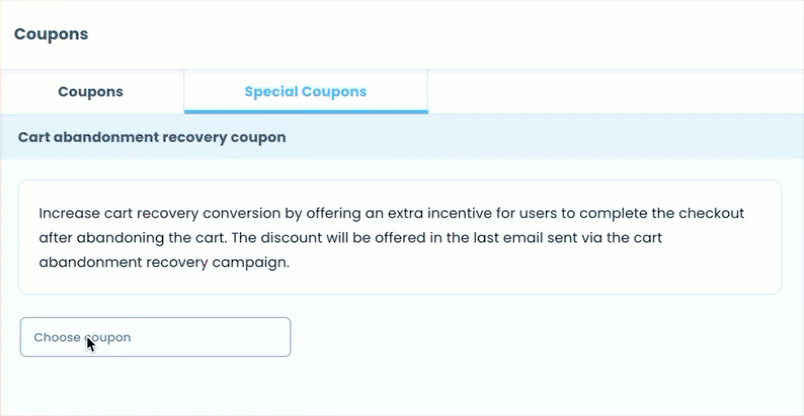
Our team built the discounts logic on top of our coupon infrastructure to give you complete control over whether the discount applies to the first payment or the first payment + subscription renewals. With this functionality, you have one more effective (final) attempt to win over potential customers:
Exit Intent Discount (With 60-Min FOMO)
An average of 69% of online checkouts are not completed (it’s as high as 85% on mobile). Because prospects have shown intent to purchase, having the means to capture carts is one of the biggest opportunities to positively impact revenue.
Enter the exit intent discount — a special discount or promotional offer that pops up to potential customers who are about to leave a website or abandon their carts. It’s a simple, cost-effective tactic that can make a huge difference to your revenue stream.
‘But I already have an abandoned carts email campaign ready to deploy’ you say.
True! Unfortunately, an Email Cart Abandonment Recovery mechanism is only effective if the prospect entered their email address before abandoning. For this reason, a complementary exit intent discount is a powerful practice to nudge those who are on the cusp of leaving back into a purchasing mindset. Here’s how we do it:
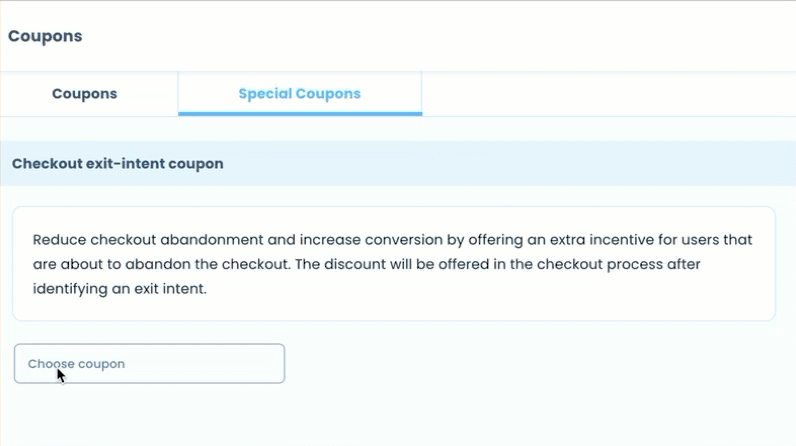
Once a coupon is set, every person who shows an exit intent before inputting their email will be presented with a FOMO (fear of missing out) dialog that includes a 60-minute timer:
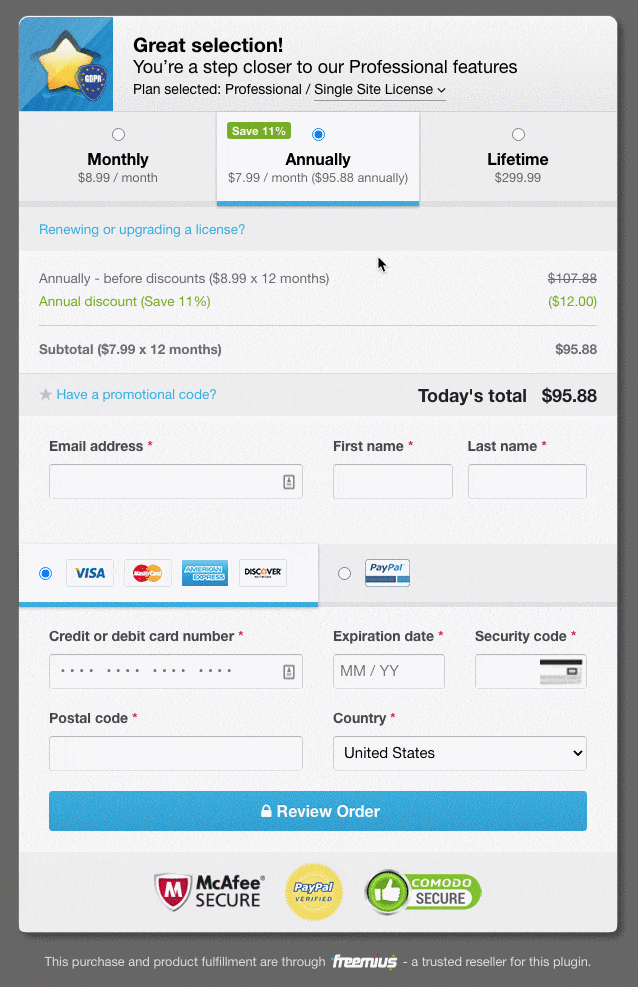
When a potential customer applies the coupon, the FOMO countdown timer will then appear right next to the coupon row. Displaying the countdown at checkout drives home the fact that the offer’s time is fleeting, which will hopefully be all the motivation unsure prospects need to hit the ‘buy’ button.
From winning new customers to retaining existing ones…
Subscription Renewal Recovery Discount
Customers often end their subscriptions before the product license expires and this window between cancellation and expiration presents a solid opportunity to bring ‘lost customers’ back to your business.
Many software product makers who rely on subscription renewals will have already implemented a renewal recovery email campaign to persuade users to rethink their cancellations. These emails typically begin by presenting the ongoing value a customer will lose out on when their license expires (some will offer renewal discounts too).
While this approach is serviceable, it’s also a missed opportunity and usually not enough to get the customer to take action right away. There’s also a good chance they’ll forget about the email and the renewal altogether.
So what is this ‘missed opportunity’ I speak of?
It’s URGENCY!
Just like with the exit-intent FOMO discount, making it clear the discount is time-limited will help increase conversions and push them to take action now.
Here’s how it’s set up in our dashboard:
Here’s the copy we use in the email:
Clicking the CTA button will open the checkout with the discount applied. Because FOMO can often be the deciding factor for ‘fence sitters’, a countdown is displayed alongside the discount to encourage users to take action before time runs out:
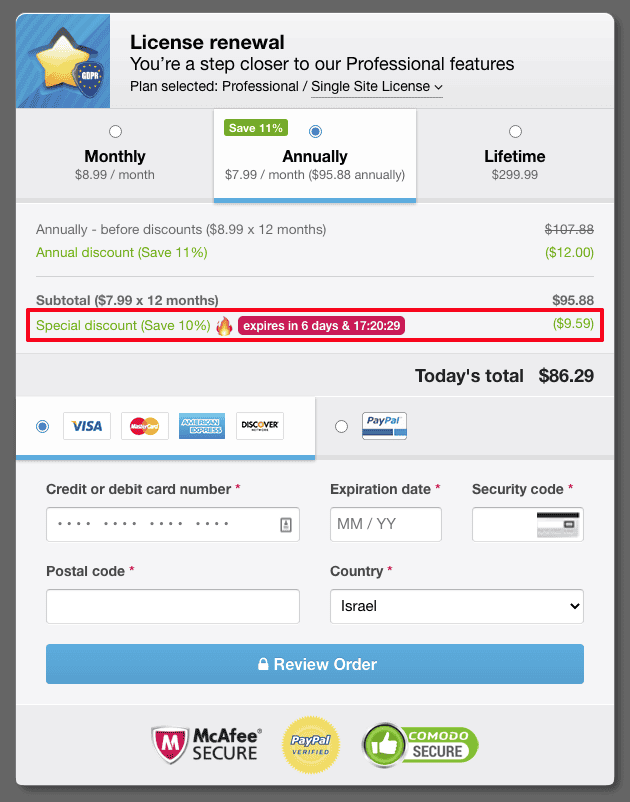
Subscription Cancellation Coupon
Customers will often cancel their subscriptions to trim down costs, despite still valuing your product and wanting to use it. This ‘cost-cutting’ has become particularly apparent in the financial crisis following the COVID-19 pandemic.
There will also be customers who prefer to avoid having active subscriptions. This is fair, but not optimal for you as a business owner because these types of customers may not renew their subscriptions (even if that was their plan initially).
In both cases, it’s better to have them on active subscriptions. One way to achieve this is to make them aware of potential price changes with a ‘red alert’ message (you can see how we display this in the visual further down). Price changes are to be expected and this method gives customers a heads up so they can secure their current pricing. Fair for both parties, I’d say.
But even with a ‘red alert’ in place, there will still be customers who’ll want to cancel, and if you let them just end their subscriptions immediately, 100% of them will if there’s no option for any other outcome 😅
For this reason, it’s a good practice to try and change their decision by being quick on the proverbial trigger with a subscription cancellation coupon (one of the star players in a developer’s tactical game against attrition). The moment a user cancels a product’s subscription auto-renewal, a pop-up flashes onto the screen to give them pause before they commit 100% to cancellation.
Here’s what it looks like for users who are initiating a cancellation in the Freemius User Dashboard:
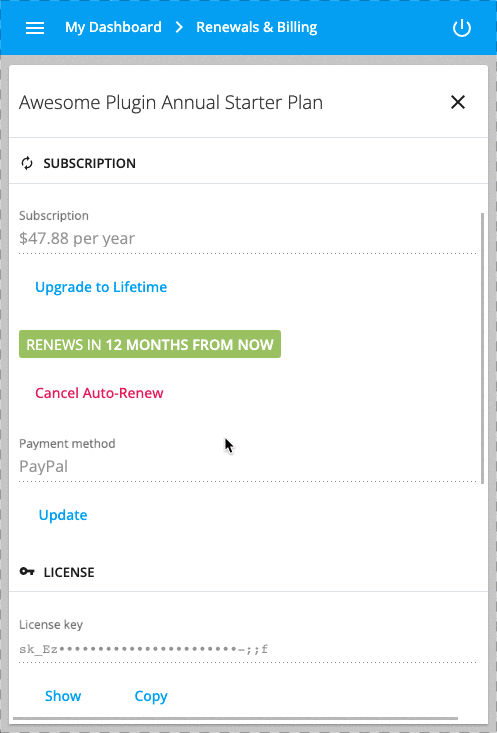
Make it easy!
You must allow customers to apply the discount with a single click. If they need to go through a checkout process again and fill in their credit card details, they’ll likely just give up and cancel the subscription. Developers can also choose to apply the discount once or for all future renewals.
Speaking of the future:
Reducing Customer Churn Is Just One Part of the Roadmap to Success
We’ve shown that — in addition to providing stellar customer service, an excellent user experience, savvy pricing, etc. — there are practical (contextual) mechanisms that can surprise, delight, and retain users at the moment they’re thinking of canceling or abandoning a purchase.
But it’s not just about retaining customers; it’s about impressing them and making them feel ‘seen’ at every turn. In a world of pixels and code, the battle for loyalty is fierce, and it’s up to you to ensure everything you deliver — from smaller features like contextual discounts to overarching services such as customer support and user experience — is done so at the highest possible level. When the moving parts are created intentionally, it’s only a matter of time before everything comes together and paves the way for business success 🤠
If you’re concerned about customer churn and would like a free appraisal and expert advice, please get in touch with us at [email protected].
